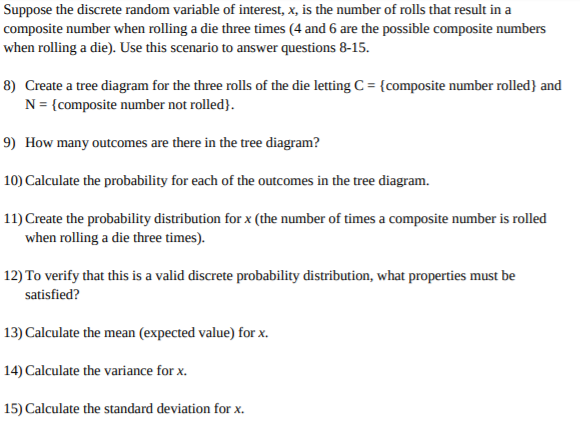Suppose the discrete random variable of interest, x, is the number of rolls that result in a composite number when rolling a die three times (4 and 6 are the possible composite numbers when rolling a die). Use this scenario to answer questions 8-15. 8) Create a tree diagram for the three rolls of the die letting C= {composite number rolled} and N = {composite number not rolled). 9) How many outcomes are there in the tree diagram? 10) Calculate the probability for each of the outcomes in the tree diagram. 11) Create the probability distribution for x (the number of times a composite number is rolled when rolling a die three times). 12) To verify that this is a valid discrete probability distribution, what properties must be satisfied? 13) Calculate the mean (expected value) for x. 14) Calculate the variance for x. 15) Calculate the standard deviation forx
Suppose the discrete random variable of interest, x, is the number of rolls that result in a composite number when rolling a die three times (4 and 6 are the possible composite numbers when rolling a die). Use this scenario to answer questions 8-15. 8) Create a tree diagram for the three rolls of the die letting C= {composite number rolled} and N = {composite number not rolled). 9) How many outcomes are there in the tree diagram? 10) Calculate the probability for each of the outcomes in the tree diagram. 11) Create the probability distribution for x (the number of times a composite number is rolled when rolling a die three times). 12) To verify that this is a valid discrete probability distribution, what properties must be satisfied? 13) Calculate the mean (expected value) for x. 14) Calculate the variance for x. 15) Calculate the standard deviation forx
Algebra & Trigonometry with Analytic Geometry
13th Edition
ISBN:9781133382119
Author:Swokowski
Publisher:Swokowski
Chapter10: Sequences, Series, And Probability
Section10.8: Probability
Problem 32E
Related questions
Question
need answers to questions 9 and 10

Transcribed Image Text:Suppose the discrete random variable of interest, x, is the number of rolls that result in a
composite number when rolling a die three times (4 and 6 are the possible composite numbers
when rolling a die). Use this scenario to answer questions 8-15.
8) Create a tree diagram for the three rolls of the die letting C= {composite number rolled} and
N = {composite number not rolled).
9) How many outcomes are there in the tree diagram?
10) Calculate the probability for each of the outcomes in the tree diagram.
11) Create the probability distribution for x (the number of times a composite number is rolled
when rolling a die three times).
12) To verify that this is a valid discrete probability distribution, what properties must be
satisfied?
13) Calculate the mean (expected value) for x.
14) Calculate the variance for x.
15) Calculate the standard deviation forx
Expert Solution
This question has been solved!
Explore an expertly crafted, step-by-step solution for a thorough understanding of key concepts.
This is a popular solution!
Trending now
This is a popular solution!
Step by step
Solved in 3 steps with 2 images

Follow-up Questions
Read through expert solutions to related follow-up questions below.
Follow-up Question
create the
Solution
Knowledge Booster
Learn more about
Need a deep-dive on the concept behind this application? Look no further. Learn more about this topic, statistics and related others by exploring similar questions and additional content below.Recommended textbooks for you

Algebra & Trigonometry with Analytic Geometry
Algebra
ISBN:
9781133382119
Author:
Swokowski
Publisher:
Cengage


Algebra & Trigonometry with Analytic Geometry
Algebra
ISBN:
9781133382119
Author:
Swokowski
Publisher:
Cengage
